Johnson R.S. A Modern Introduction to the Mathematical Theory of Water Waves
Подождите немного. Документ загружается.

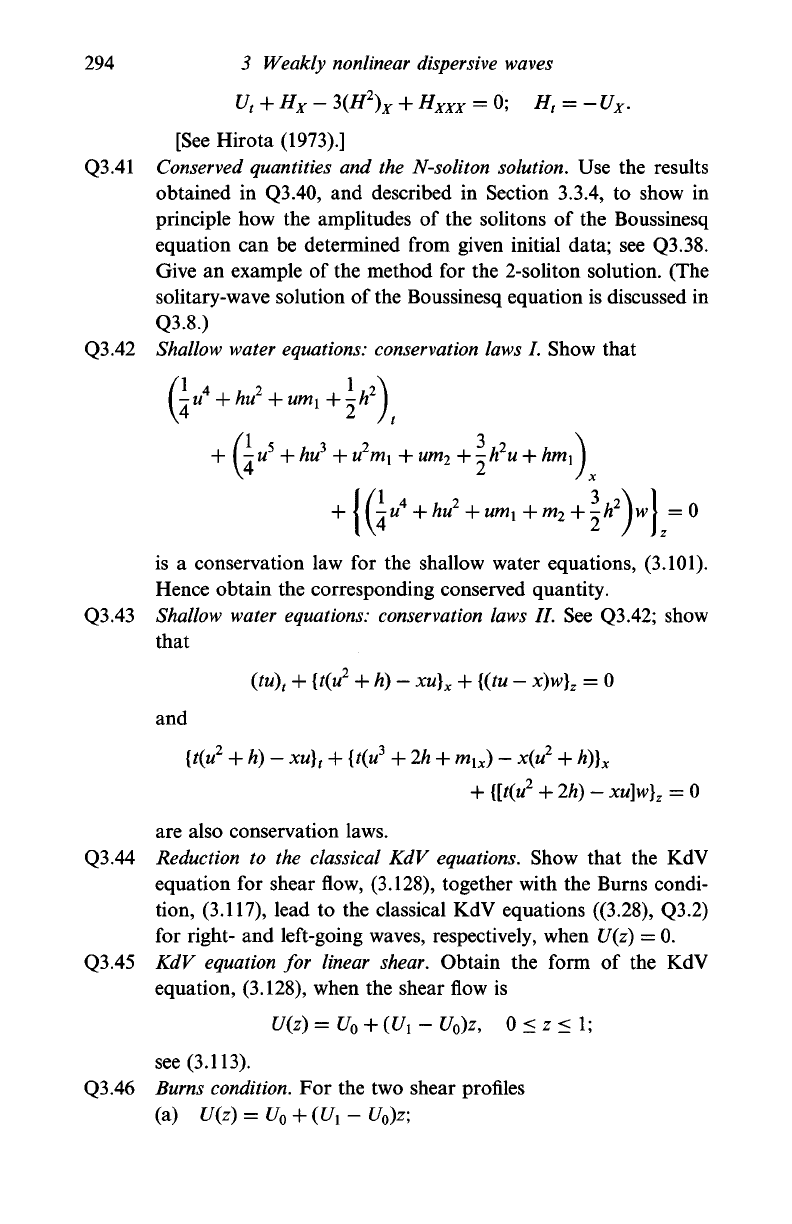
294
3
Weakly nonlinear dispersive waves
U
t
+
H
x
-3(H
2
)
x
+ H
xxx
=
0;
H
t
= -U
x
.
[See Hirota (1973).]
Q3.41 Conserved quantities
and the
N-soliton solution.
Use the
results
obtained
in
Q3.40,
and
described
in
Section 3.3.4,
to
show
in
principle
how the
amplitudes
of the
solitons
of the
Boussinesq
equation
can be
determined from given initial data;
see
Q3.38.
Give
an
example
of the
method
for the
2-soliton solution.
(The
solitary-wave solution
of
the Boussinesq equation
is
discussed
in
Q3.8.)
Q3.42 Shallow water equations: conservation laws
I.
Show that
+
\-u
5
+hu
+u m\ +
umr
+
- h
2
u
+
hm\
\
V
4
2 )
x
-u*
+ hu
z
+
um
x
+m
2
+-h
1
\w\
=i
P
z
is
a
conservation
law for the
shallow water equations, (3.101).
Hence obtain
the
corresponding conserved quantity.
Q3.43 Shallow water equations: conservation laws
II. See
Q3.42; show
that
(tu)
t
+
{t(u
2
+
h)
- xu}
x
+
{(tu
- x)w}
z
= 0
and
{t(u
2
+
h)
- xu}
t
+
{t(u
3
+2h + m
lx
) - x(u
2
+
A)},
+
{[t(u
2
+ 2A) -
XM]W}
2
= 0
are also conservation laws.
Q3.44 Reduction
to the
classical
KdV
equations. Show that
the KdV
equation
for
shear flow, (3.128), together with
the
Burns condi-
tion, (3.117), lead
to the
classical
KdV
equations ((3.28),
Q3.2)
for right-
and
left-going waves, respectively, when
U(z) = 0.
Q3.45
KdV
equation
for
linear shear. Obtain
the
form
of the KdV
equation, (3.128), when
the
shear flow
is
see (3.113).
Q3.46 Burns condition.
For the two
shear profiles
(a) U(z)
=
U
0
+
(U
l
-U
0
)z;
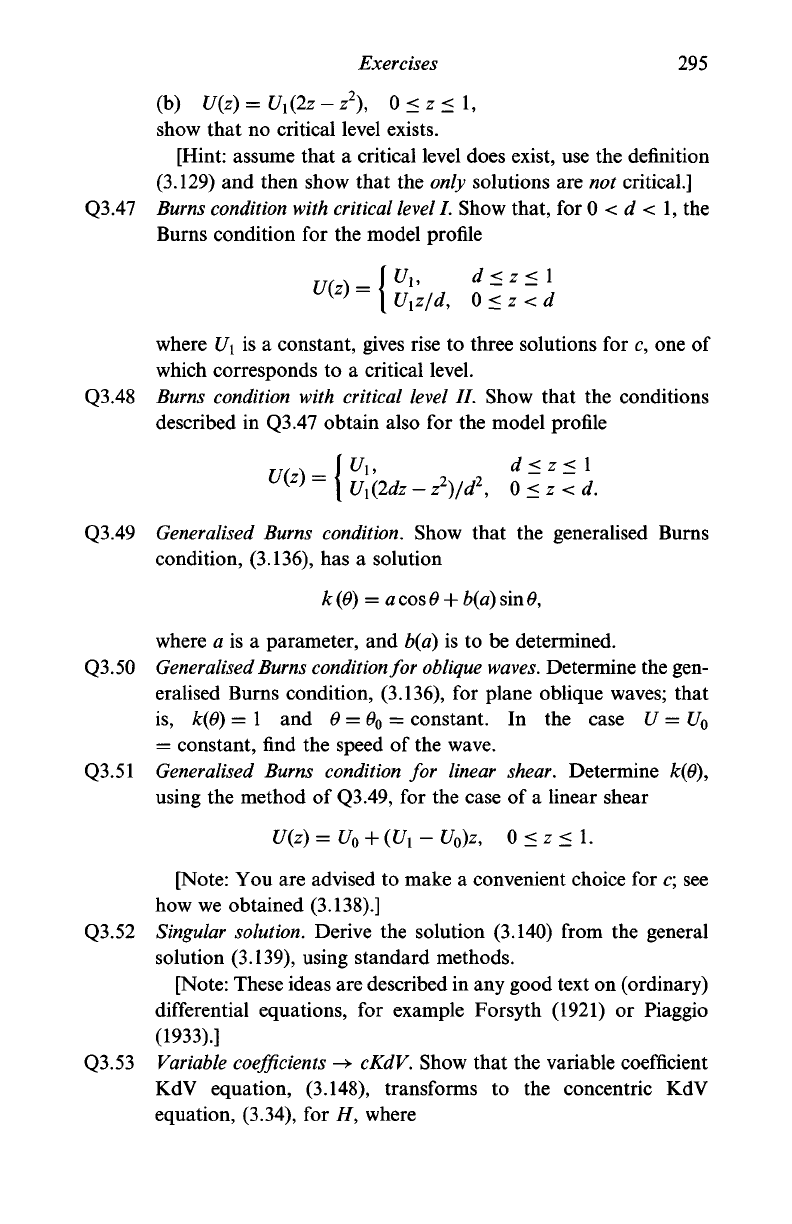
Exercises 295
(b) U(z)=U
l
(2z-z
2
), 0<z<l,
show that no critical level exists.
[Hint: assume that a critical level does exist, use the definition
(3.129) and then show that the only solutions are not critical.]
Q3.47
Burns condition with critical level
I. Show that, for 0 < d < 1, the
Burns condition for the model profile
d<z< 1
0 <z < d
where U\ is a constant, gives rise to three solutions for c, one of
which corresponds to a critical level.
Q3.48 Burns
condition
with critical level II. Show that the conditions
described in Q3.47 obtain also for the model profile
U
u
d<z<l
U
{
(2dz-z
2
)/d\
0<z<d.
Q3.49
Generalised
Burns
condition.
Show that the generalised Burns
condition, (3.136), has a solution
k(0) = a
cos 0
+
b(a)
sin 0,
where a is a parameter, and b(a) is to be determined.
Q3.50
Generalised Burns
condition for
oblique
waves. Determine the gen-
eralised Burns condition, (3.136), for plane oblique waves; that
is,
k(0) =
1
and 0 =
9Q
= constant. In the case U = U
o
= constant, find the speed of the wave.
Q3.51
Generalised
Burns
condition
for linear shear. Determine k(0),
using the method of Q3.49, for the case of a linear shear
U(z) =U
0
+ (U
{
-
U
0
)z
9
0 < z < 1.
[Note: You are advised to make a convenient choice for
c;
see
how we obtained (3.138).]
Q3.52 Singular
solution.
Derive the solution (3.140) from the general
solution (3.139), using standard methods.
[Note: These ideas are described in any good text on (ordinary)
differential equations, for example Forsyth (1921) or Piaggio
(1933).]
Q3.53
Variable coefficients
->
cKdV.
Show that the variable coefficient
KdV equation, (3.148), transforms to the concentric KdV
equation, (3.34), for //, where
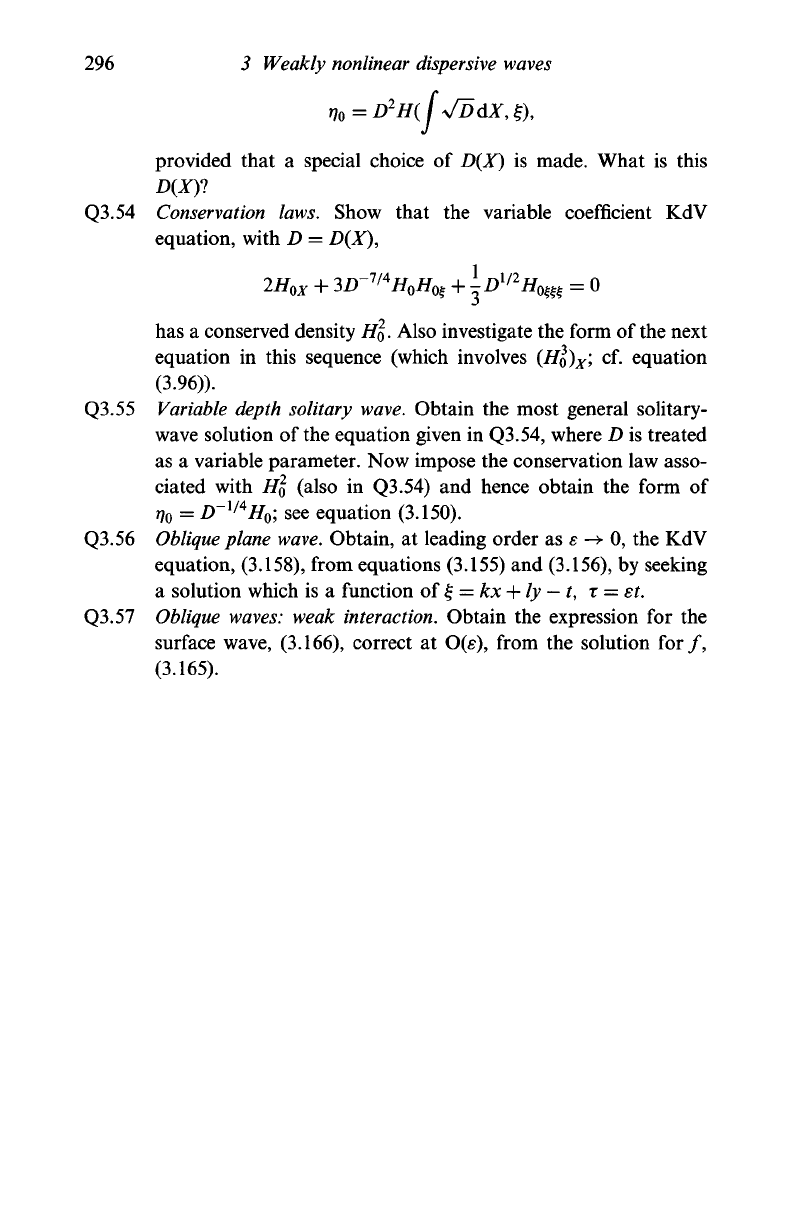
296 3 Weakly nonlinear dispersive waves
provided that a special choice of D(X) is made. What is this
Q3.54 Conservation laws. Show that the variable coefficient KdV
equation, with D = D(X),
r\ TT I O
7"\—7/4
TT TT I
TAI/2
TT f\
zn
ox
"•"
^
u n
o
n
$$ "5 °^
= u
has a conserved density
HQ.
Also investigate the form of the next
equation in this sequence (which involves
(HQ)
X
; cf. equation
(3.96)).
Q3.55 Variable depth solitary wave. Obtain the most general solitary-
wave solution of the equation given in Q3.54, where D is treated
as a variable parameter. Now impose the conservation law asso-
ciated with HQ (also in Q3.54) and hence obtain the form of
see equation (3.150).
Q3.56 Oblique plane wave. Obtain, at leading order as e -> 0, the KdV
equation, (3.158), from equations (3.155) and (3.156), by seeking
a solution which is a function of £ = kx + ly
—
t, r = st.
Q3.57 Oblique waves: weak interaction. Obtain the expression for the
surface wave, (3.166), correct at O(s), from the solution for/,
(3.165).
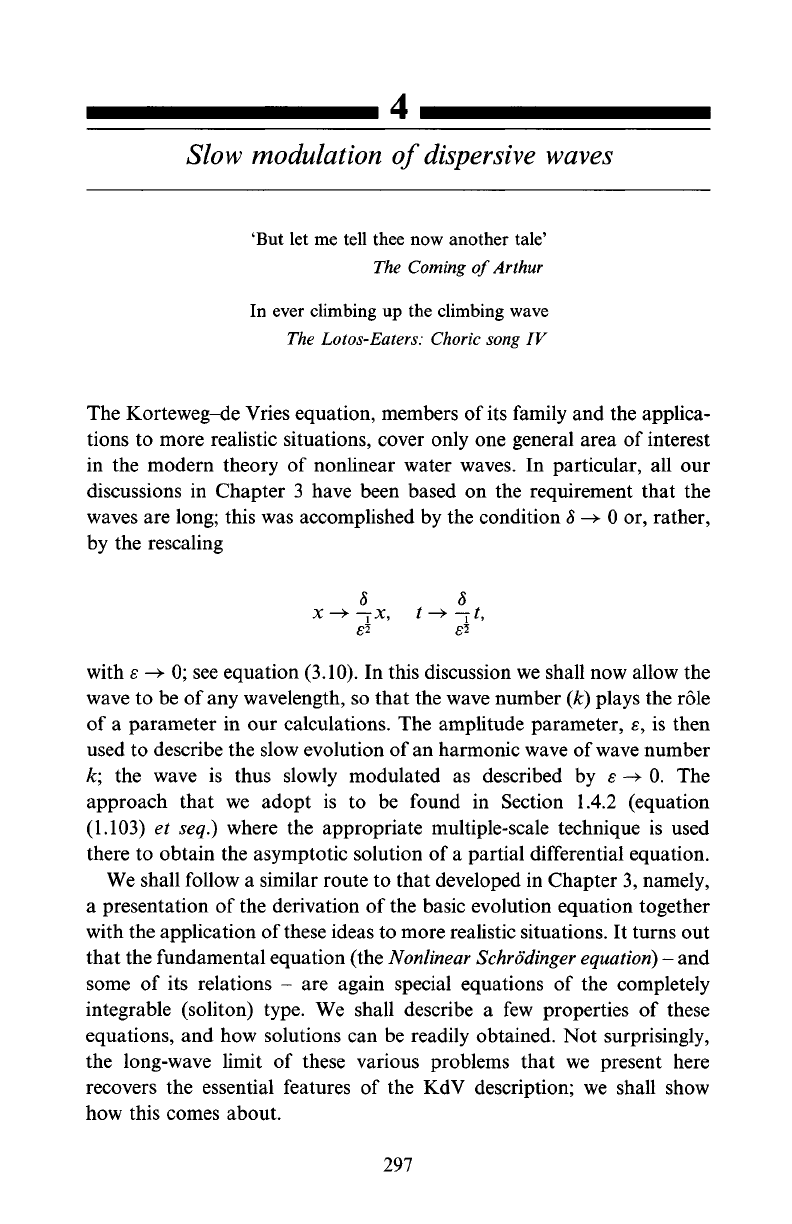
Slow modulation of
dispersive
waves
'But let me tell thee now another tale'
The Coming of Arthur
In ever climbing up the climbing wave
The Lotos-Eaters: Choric song IV
The Korteweg-de Vries equation, members of
its
family and the applica-
tions to more realistic situations, cover only one general area of interest
in the modern theory of nonlinear water waves. In particular, all our
discussions in Chapter 3 have been based on the requirement that the
waves are long; this was accomplished by the condition
8
-> 0 or, rather,
by the rescaling
8 8
x
—>
—
x,
t
—> —
t,
£2 £2
with s -> 0; see equation (3.10). In this discussion we shall now allow the
wave to be of any wavelength, so that the wave number (k) plays the role
of a parameter in our calculations. The amplitude parameter, £, is then
used to describe the slow evolution of an harmonic wave of wave number
k; the wave is thus slowly modulated as described by £ -> 0. The
approach that we adopt is to be found in Section 1.4.2 (equation
(1.103) et seq.) where the appropriate multiple-scale technique is used
there to obtain the asymptotic solution of a partial differential equation.
We shall follow a similar route to that developed in Chapter
3,
namely,
a presentation of the derivation of the basic evolution equation together
with the application of these ideas to more realistic situations. It turns out
that the fundamental equation (the
Nonlinear Schrodinger equation)
- and
some of its relations - are again special equations of the completely
integrable (soliton) type. We shall describe a few properties of these
equations, and how solutions can be readily obtained. Not surprisingly,
the long-wave limit of these various problems that we present here
recovers the essential features of the KdV description; we shall show
how this comes about.
297
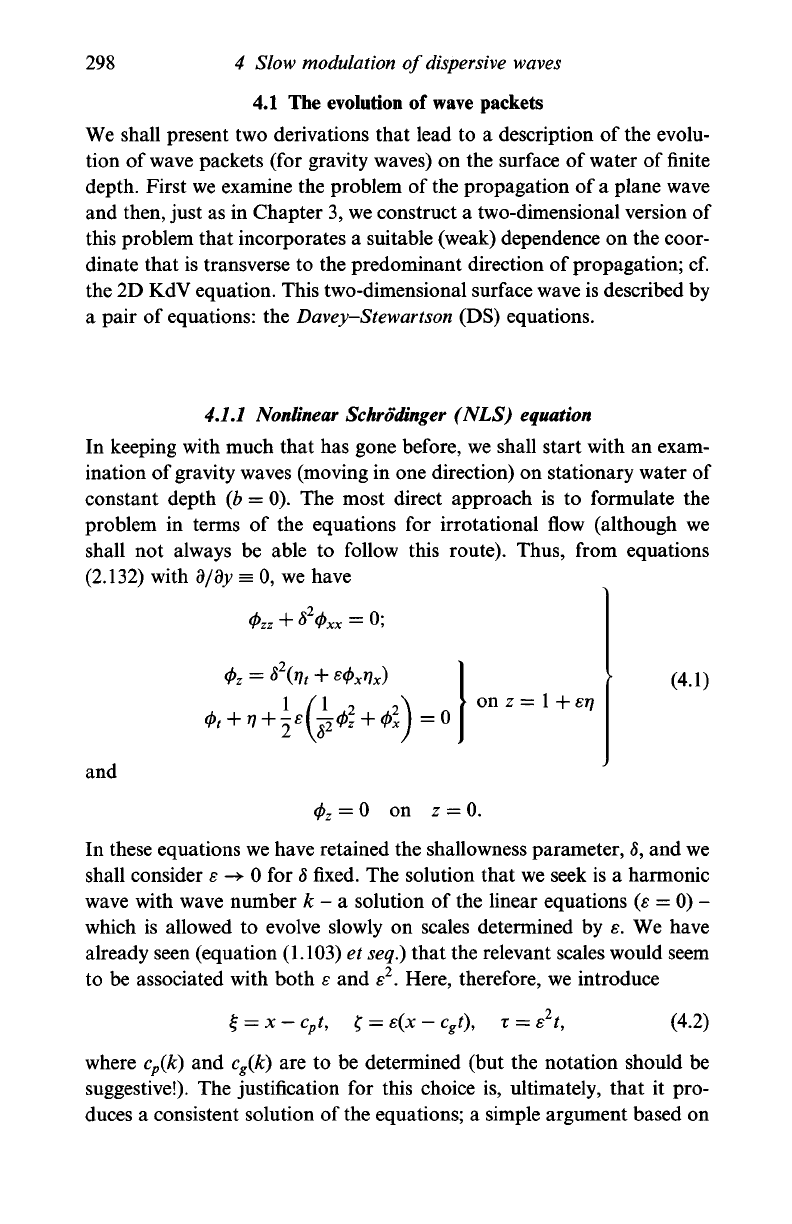
298
4 Slow modulation of dispersive waves
4.1 The evolution of wave packets
We shall present two derivations that lead to a description of the evolu-
tion of
wave
packets (for gravity waves) on the surface of water of finite
depth. First we examine the problem of the propagation of a plane wave
and then, just as in Chapter 3, we construct a two-dimensional version of
this problem that incorporates a suitable (weak) dependence on the coor-
dinate that is transverse to the predominant direction of propagation; cf.
the 2D KdV equation. This two-dimensional surface wave is described by
a pair of equations: the Davey-Stewartson (DS) equations.
4.1.1 Nonlinear Schrodinger (NLS) equation
In keeping with much that has gone before, we shall start with an exam-
ination of gravity waves (moving in one direction) on stationary water of
constant depth (b = 0). The most direct approach is to formulate the
problem in terms of the equations for irrotational flow (although we
shall not always be able to follow this route). Thus, from equations
(2.132) with d/dy = 0, we have
(j)
zz
+ 8 (j)
xx
= 0;
on z =
1
+
srj
and
(4.1)
= 0 on z = 0.
In these equations we have retained the shallowness parameter,
8,
and we
shall consider e -> 0 for
8
fixed.
The solution that we seek is a harmonic
wave with wave number k - a solution of the linear equations (e = 0) -
which is allowed to evolve slowly on scales determined by s. We have
already seen (equation (1.103) et
seq.)
that the relevant scales would seem
to be associated with both e and s
2
. Here, therefore, we introduce
= x
—
c
p
t, f = s(x
—
c
g
t), x — s
2
t,
(4.2)
where c
p
(k) and c
g
(k) are to be determined (but the notation should be
suggestive!). The justification for this choice is, ultimately, that it pro-
duces a consistent solution of the equations; a simple argument based on
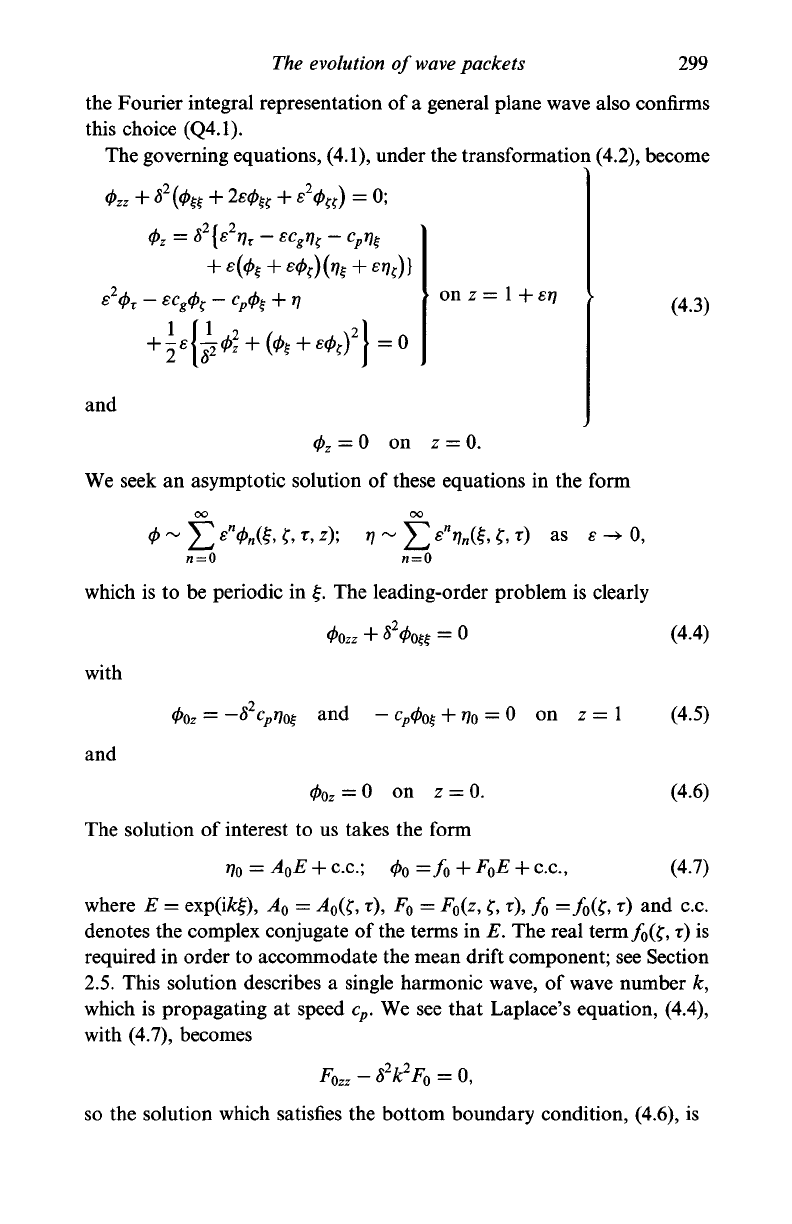
The evolution of wave packets
299
the Fourier integral representation of a general plane wave also confirms
this choice (Q4.1).
The governing equations, (4.1), under the transformation (4.2), become
<t>z
*
2
0r " '
- 0;
-
c
p
(j)
H
on z =
1
+
srj
and
0
Z
= 0 on z = 0.
We seek an asymptotic solution of these equations in the form
oo oo
which is to be periodic in £. The leading-order problem is clearly
with
and
and -
= 0 on z =
0
Oz
= 0 on z = 0.
The solution of interest to us takes the form
r/
0
= A
0
E + c.c; 0
O
=/
0
(4.3)
(4.4)
(4.5)
(4.6)
(4.7)
where E = exp(ifc£), A
o
= A
0
(S, r), F
o
= F
0
(z, f, r), /
0
=/
0
(f,
T)
and c.c.
denotes the complex conjugate of the terms in E. The real
term/
0
(f,
r) is
required in order to accommodate the mean drift component; see Section
2.5.
This solution describes a single harmonic wave, of wave number k,
which is propagating at speed c
p
. We see that Laplace's equation, (4.4),
with (4.7), becomes
F
Ozz
-
8
2
k
2
F
0
= 0,
so the solution which satisfies the bottom boundary condition, (4.6), is
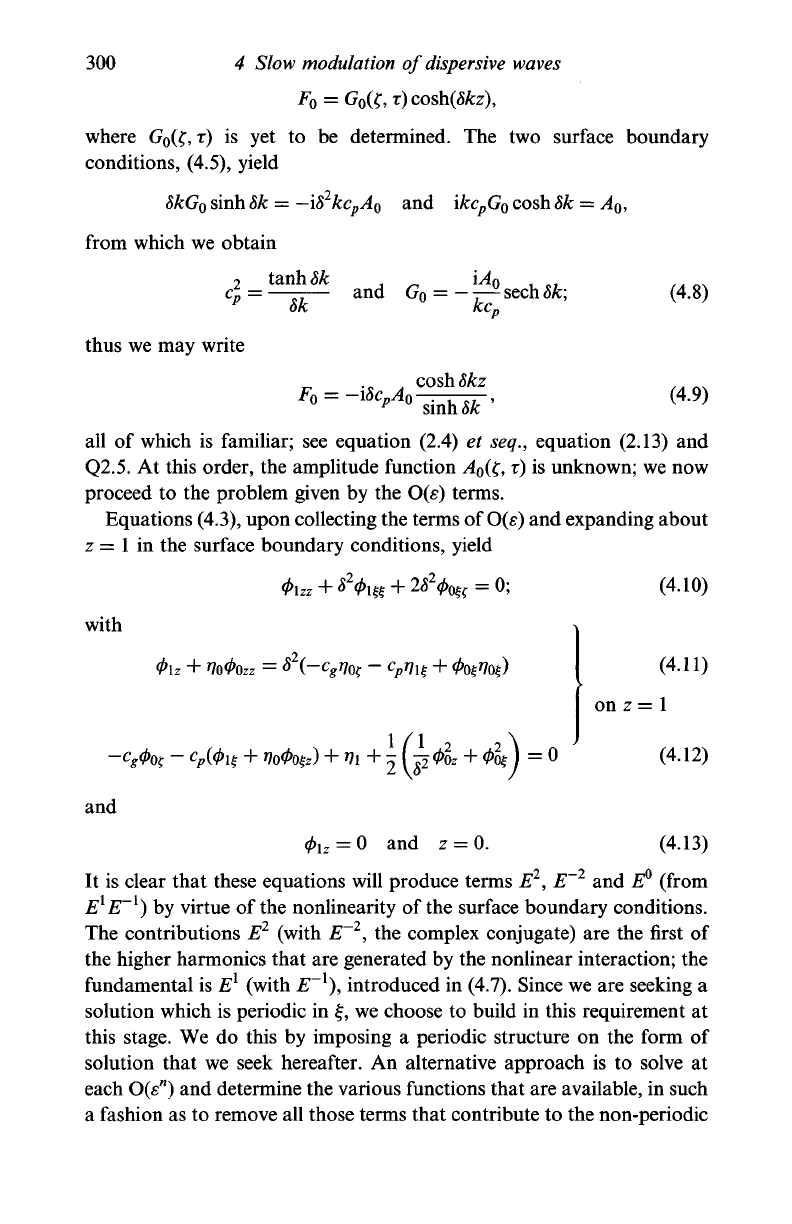
300 4 Slow modulation of dispersive waves
where G
0
(f, r) is yet to be determined. The two surface boundary
conditions, (4.5), yield
8kG
0
sinh 8k = —i8
2
kc
p
A
0
and ikc
p
G
0
cosh 8k = A
o
,
from which we obtain
tanhSA;
C
P=-
thus we may write
—— and G
0
= -T-^sech5A:;
8k kc
n
cosh
8kz
]
sinh 8k '
(4.8)
(4.9)
all of which is familiar; see equation (2.4) et seq., equation (2.13) and
Q2.5.
At this order, the amplitude function
A
0
(t;,
r) is unknown; we now
proceed to the problem given by the O(^) terms.
Equations (4.3), upon collecting the terms of
O(e)
and expanding about
z =
1
in the surface boundary conditions, yield
= 0;
(4.10)
with
j
f ^2
(4.11)
on z = 1
= 0
and
lz
=
O
and z = 0.
(4.12)
(4.13)
It is clear that these equations will produce terms E
2
, E~
2
and Ep (from
E
l
E~
l
) by virtue of the nonlinearity of the surface boundary conditions.
The contributions E
2
(with E~
2
, the complex conjugate) are the first of
the higher harmonics that are generated by the nonlinear interaction; the
fundamental is E
l
(with E~
l
), introduced in (4.7). Since we are seeking a
solution which is periodic in £, we choose to build in this requirement at
this stage. We do this by imposing a periodic structure on the form of
solution that we seek hereafter. An alternative approach is to solve at
each O(e
n
) and determine the various functions that are available, in such
a fashion as to remove all those terms that contribute to the non-periodic
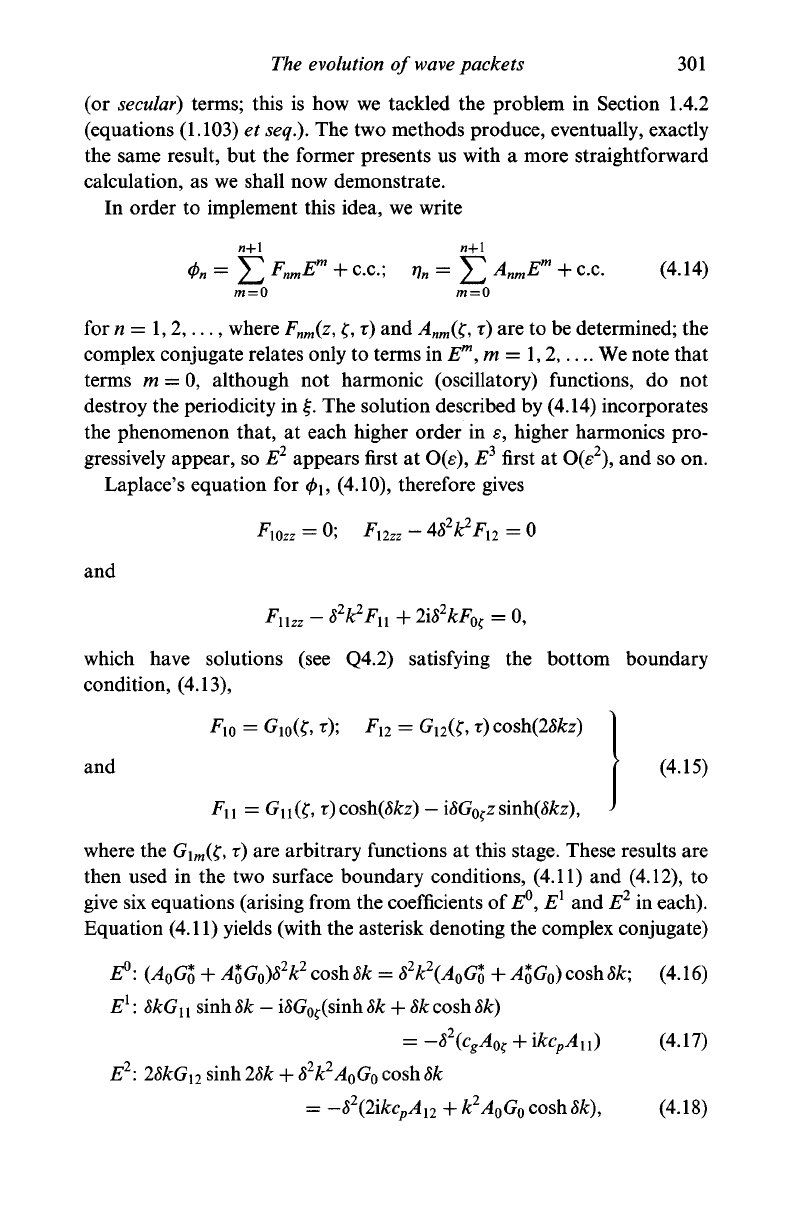
The evolution of
wave
packets 301
(or secular) terms; this is how we tackled the problem in Section 1.4.2
(equations (1.103) et
seq.).
The two methods produce, eventually, exactly
the same result, but the former presents us with a more straightforward
calculation, as we shall now demonstrate.
In order to implement this idea, we write
w+l
w+1
4>n
= J^
F
nm
E
m
+
c.c;
rin
= £
A
nm
E
m
+
c.c.
(4.14)
ra
= 0
m
=
0
for
w
=
1,2,...,
where F
nm
(z, f, r) and A
nm
(t;, r) are to be determined; the
complex conjugate relates only to terms in E
m
, m = 1, 2, We note that
terms m
—
0, although not harmonic (oscillatory) functions, do not
destroy the periodicity in £. The solution described by (4.14) incorporates
the phenomenon that, at each higher order in e, higher harmonics pro-
gressively appear, so E
2
appears first at O(e), E
3
first at O(£
2
), and so on.
Laplace's equation for 0
1?
(4.10), therefore gives
*io« = O; F
l2zz
-48
2
^F
l2
= 0
and
which have solutions (see Q4.2) satisfying the bottom boundary
condition, (4.13),
);
F
n =
G
l2
((,
r) cosh(28kz)
and I (4.15)
F
n
= Gn(f, r)cosh(8kz) -
where the
G\
m
(£,
r) are arbitrary functions at this stage. These results are
then used in the two surface boundary conditions, (4.11) and (4.12), to
give six equations (arising from the coefficients of E°, E
l
and E
2
in each).
Equation (4.11) yields (with the asterisk denoting the complex conjugate)
E°:
(A
0
G*
0
+
A%G
0
)8
2
k
2
cosh 8k
=
8
2
k
2
(A
o
Go
+
^o^o)
cosh8k;
(4.16)
E
l
:
8kG
x
x
sinh 8k
-
i^G
0
^(sinh
8k
+
8k cosh
8k)
= -8
2
{c
g
A^ + ikc
p
A
n
)
(4.17)
E
2
:
28kG
l2
sinh28k
+ 8
2
k
2
A
0
G
0
cosh 8k
=
-8
2
(2ikc
p
A
l2
+
k
2
A
0
G
0
cosh
8k),
(4.18)
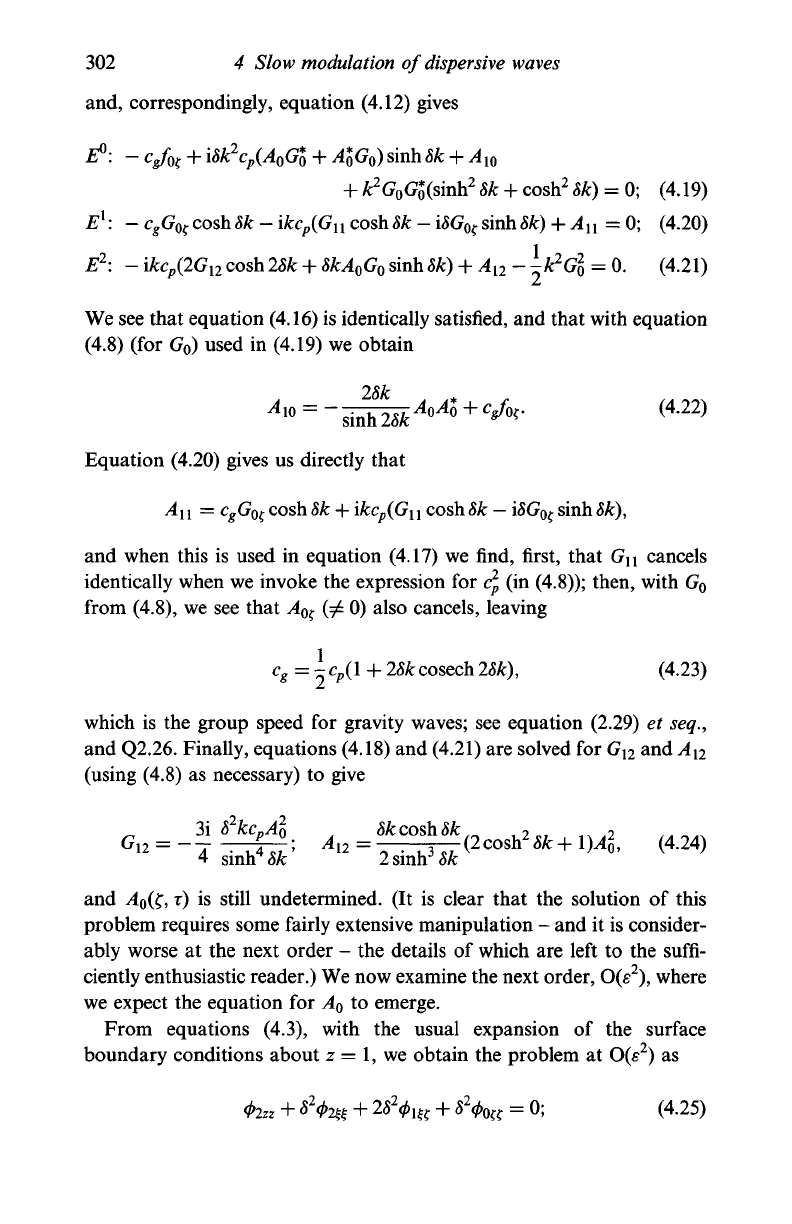
302 4 Slow modulation of dispersive waves
and, correspondingly, equation (4.12) gives
E°'. - c/ot; + i8k
2
c
p
(A
0
G*
0
+
A*
0
G
0
)
sinh 8k + A
l0
+ ^GoG^sinh
2
8k + cosh
2
8k) = 0; (4.19)
E
l
: - c
g
G^ cosh 8k - ikc
p
(G
n
cosh 8k -
i8G
0
^
sinh 8k) + A
u
=0; (4.20)
£
2
: - i^(2G
12
cosh28k + 5fc^
o
^o sinh8k) +
v4
12
- )-&G\ = 0. (4.21)
We see that equation (4.16) is identically satisfied, and that with equation
(4.8) (for G
o
) used in (4.19) we obtain
28k
A A
^
+
Equation (4.20) gives us directly that
A
u
=
c
g
G
0
£
cosh8k + ikc
p
(G
u
cosh8k
—
iSG^ sinh8k),
and when this is used in equation (4.17) we find, first, that G
n
cancels
identically when we invoke the expression for
c
2
p
(in (4.8)); then, with G
o
from (4.8), we see that A^ (^ 0) also cancels, leaving
c
g = \
C
P(
1
+
28k cosech m
)'
(
4
-
23
)
which is the group speed for gravity waves; see equation (2.29) et seq.,
and Q2.26. Finally, equations (4.18) and (4.21) are solved for G
12
and A
n
(using (4.8) as necessary) to give
3i 8
2
kc
p
Al 8kcosh8k^ ,
2 of iX j2
,^^
G
i2 = —7 -VI77; A
n
=-—j—(2cosh
2
8k+l)Al (4.24
4 sinh fifc 2smh 5A:
and
v4
0
(f,
r) is still undetermined. (It is clear that the solution of this
problem requires some fairly extensive manipulation - and it is consider-
ably worse at the next order - the details of which are left to the suffi-
ciently enthusiastic reader.) We now examine the next order,
O(s
2
),
where
we expect the equation for A
o
to emerge.
From equations (4.3), with the usual expansion of the surface
boundary conditions about z = 1, we obtain the problem at O(£
2
) as
<^ott
= 0; (4.25)
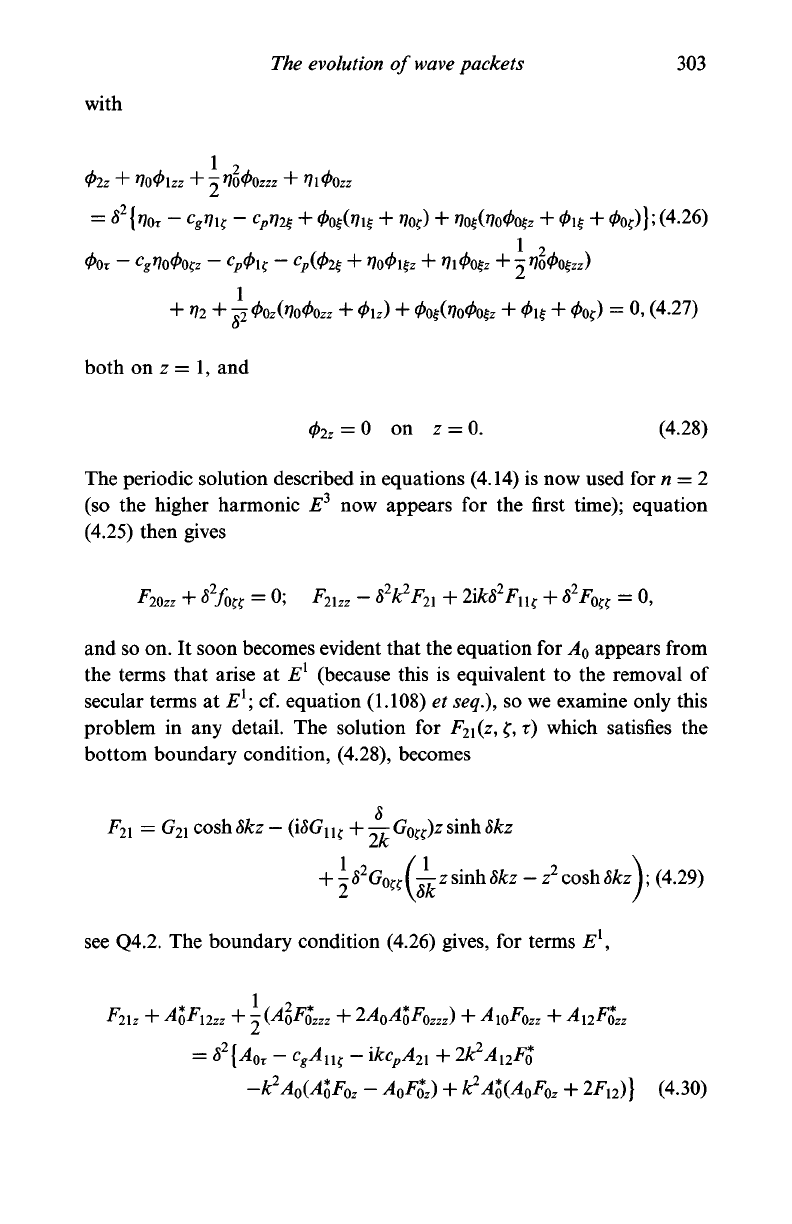
The evolution of wave packets 303
with
02z j
= ^faor ~ c
g
ri
H
-
c
p
ri2i:
+ 0o^(^7i^ + W + *to$foo0O*z + 0i| +
00^)};
(4.26)
0Or - <^O0O£z ~
Cp<t
both on z = 1, and
= 0 on z = 0. (4.28)
The periodic solution described in equations (4.14) is now used for n = 2
(so the higher harmonic E
3
now appears for the first time); equation
(4.25) then gives
FTOZZ
+ S
2
/^ = 0; F
2
izz -
8
2
k
2
F
2X
+ 2ik8
2
F
lH
+
8
2
F
Q
^
= 0,
and so on. It soon becomes evident that the equation for A
o
appears from
the terms that arise at E
l
(because this is equivalent to the removal of
secular terms at E
l
; cf. equation (1.108) et
seq.),
so we examine only this
problem in any detail. The solution for F
2
\(z
9
f, r) which satisfies the
bottom boundary condition, (4.28), becomes
F
2l
= G
2X
cosh8kz - (i8G
XH
+ — G
0
^)zsinh8kz
+
-8
2
G
m
(-—
z sinh 8kz - z
2
cosh 8kz\ (4.29)
see Q4.2. The boundary condition (4.26) gives, for terms E
l
,
1 2
\-~J(AQFQ
ZZZ
+ 2AQAQF
0ZZZ
) +
A
X
QFQ
ZZ
+
A
X2
FQ
ZZ
= 8
2
{A
0r
-
c
g
A
XH
-
\kc
p
A
2X
+ 2fc
2
^
12
F
0
*
-k
2
A
0
(A*
0
F
0z
-
A
O
F%
Z
)
+ /^(^oz +
2F
12
)}
(4.30)
